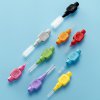Arkona composite and fibre matrix (Comcord) is a Class IIa dental medical device for use in all composite restorations where a dental fibre support is required.
It is a ready-to-use product, requiring no additional preparation prior to insertion.
Dimensions: length: 6.0 cm; width: 2.5 mm; thickness: 0.7 mm.
Packages:
1 x 1 pc.
| Category: | Reinforcement |
|---|
Properties:
- light-curing composite-fibre-composite system
- dimensions:
length - 60 mm (+ 2 x 5 mm inside the tips)
width - 2,5 ± 0,2 mm
thickness - 0,7 ± 0,1 mm
- rapid, self-contained treatment without assistance
- high ductility: modelling as simple as making a filling
- no problem of springing: the moulded fibre does not deform and remains in position

- suitable for all types of composite work
- intuitive modelling, no training required
- accessible to all patients due to relatively low treatment costs
- splinting of loose or avulsed teeth;
- support for permanent composite restorations such as fillings, crowns, bridges, onlays and inlays;
- composite bridges: conventional, Maryland and Rochette types;
- orthodontic retainers.
General instructions for use:
1. Prepare teeth in the normal way.
2. Isolate the gingiva in order to protect it from the contact with unpolymerised Comcord.
a) if using an indirect method, as in the case of a bridge or a crown, protect the teeth with vaseline or a rubber dam, take an impression and cast a model;
b) if using a direct method, as in the case of splinting isolate the operating field from blood and saliva contamination, etch, dry and apply a bonding system.
3. Polymerise in sections no longer than 5-8 mm (approximately the width of your light guide), referring to the polymerisation table.
Polymerisation table:
- lamp power density - <800 mW/cm2 - curing time - 40 sec.
- lamp power density - 800-2000 mW/cm2 - curing time - 20-30 sec.
- lamp power density - >2000 mW/cm2 - curing time - 10 sec.
Composite fibre fixation:

1. Open the aluminum pouch and remove the device. Place it with the protective covering to the light. Do not remove Comcord from the white plastic former.
2. Measure out, and if necessary cut off, the appropriate length of Comcord together with the plastic former. We recommend cutting the device with disposable blades after having placed it on a hard surface. Store the remaining part in the aluminum pouch
3. Grasp the end and hold it firmly, slowly pull Comcord out of the plastic former. Note: Comcord can only be pulled out of the plastic former by one of the orange ends, never by the end which has been previously cut.
4. Remove the protective covering from Comcord in sections and start placing it.
5. Begin by placing Comcord at one of its ends in either the deepast, or the most distant, from the labial/buccal surface, part of the prepared tooth Polymerise in accordance with the polymerisation table provided. Continue to place the remaining unpolymerised part, section by section, removing the protective covering and polymerising the product until it runs to the opposite side of the preparation. If necessary, join two pieces of Comcord by overlapping them by 2 mm - this will maintain the strength of the restoration.
6. Subsequently, either further layers of Comcord or layers of composite can be built up on the prepared reinforcement, in accordance with clinical requirements. The best results are obtained by combining Comcord with the following materials: Create, Silkflow, Colourflow Colourant, Glaze.
7. When using the in direct method, cement the restoration in position.
8. Adjust to the bite and aesthetics of the neighbouring teeth.
Principles of working with composite fibre:
- Comcord is sensitive to visible light. To avoid accidental polymerisation, release the product from the plastic former in sections, making sure the protective covering shields the unpolymerised part of Comcord from light. Comcord should only be handled using instruments. Do not touch it with your fingers or contaminate it in another way.
- Comcord can be used to form the external layer of composite restorations, regardless of their size and shape. An unlimited number of Comcord layers can be built up provided the occlusal space is sufficient and the outer layer of the device remains undisturbed. The compo- site layer covering the filament core of Comcord is approximately 0.3 mm. A single, external fracture of a filament will not affect the strength of layered Comcord restorations; however, in order to maintain a smooth surface, the damaged part should be covered with a thin layer of composite or glaze.
- Comcord can be used for direct reconstruction of contact points. The shape of the reinforcement is not important. Optimal mechanical strength of the work is ensured by running Comcord along the entire length of the restoration.
- Comcord can be used alone or it can be placed in one or several layers.
- Comcord is compatible with any composite material based on dimethacrylate resins. In the case of temporary splinting, mark a clear bounda- ry between Comcord and the tooth by placing a contrasting coloured composite, such as Colourflow, as the first layer. This will assist subsequent removal of the splint.










